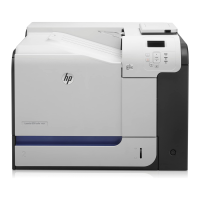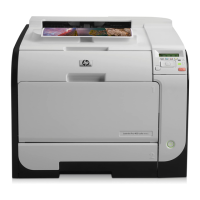8 TOP FEATURES
1. The user sends the print job to a generic queue on the server.
2. The server holds the job, pending authentication.
3. The user authenticates at the device (via the control panel or optional smartcards, swipe cards, or
biometric devices).
4. The printer pulls the job from the server and delivers it to the user.
At HP, we understand that pull printing needs vary by organization. That’s why we offer products, software,
services, and solutions—including third-party solutions from leading providers—to address your specific
security challenges. The Hardware Integration Pocket on the control panel enables advanced security
options.
2
Job retention features—Keep private documents confidential, proof a document before releasing the
remaining copies, and store frequently printed jobs at the printer for easy retrieval. Three job retention
features are included: Private/Secure Printing, Proof and Hold, and Stored Job.
Protect confidential documents with the Private/Secure Printing feature. This feature lets you specify that a job
will not be printed until you release it using a 4-digit Personal Identification Number (PIN) through the device
control panel. When you enter the PIN in the driver, it is sent to the printer as part of the print job.
For added security, choose end-to-end Secure Encrypted Print. HP UPD is the first fleet driver to provide true
symmetric AES256 print job encryption and decryption from the client to the page based on a user-defined
password
15
using a FIPS 140 validated cryptographic module from Microsoft
®
. Both the key and the job are
stored encrypted on the printer until they are released by the user.
Provides a quick and easy way to print one copy and proof it before printing the remaining copies. You can
either continue printing the remaining copies, which have been saved at the device, or cancel them from the
device control panel. After the additional copies are printed, the Proof and Hold job is deleted from the
device. This reduces network traffic, paper waste, and supplies costs.
Allows you to download a print job to the device without printing it. You can then print the job at any time
from the device’s control panel. For example, you may want to download a personnel form, calendar, time
sheet, or accounting form that other users can access and print.
Data protection—Network-transmitted data can be protected with IPsec, which allows you to encrypt data
that travels between the device and digital send destinations (provided you have configured each network
resource to use IPsec). Print jobs can also be encrypted using Internet Printing Protocol (IPP) over SSL/TLS.
Management safeguards—Device management data that travels over the network between the device and
the HP Embedded Web Server or HP Web Jetadmin can also be encrypted.
Password protection—Stored passwords are encrypted to help ensure protection of this critical information.
Hard disk encryption—Secure your business-critical data with the HP High Performance Secure Hard Disk.
Once configured, the hard disk automatically encrypts stored job information (available on the M551xh).
Secure File Erase and Disk Erase—The printer provides built-in capability for overwriting data stored on it,
allowing sensitive data to be safely removed. HP offers multiple mechanisms to erase stored data, including
sanitized erase functionality that conforms to U.S. National Institute of Science and Technology (NIST)
overwrite algorithm specifications (available on the M551xh).
Access port for optional Kensington-style lock—Physically secure the printer from theft. The security access
port lets you attach an optional cable-type security lock.
Third party validation and best practices:
U.S. and Canadian Cryptographic Module Validation Program (CVMP) validates cryptographic modules
to U.S. Federal Information Processing Standards (FIPS)140. Hewlett Packard provides solutions that
align with this standard in its HP UPD 5.3 Secure Encrypted Print and HP High-performance Secure
Hard Disk solutions (available on option #201 of the M551xh model). For more information, see
http://csrc.nist.gov/groups/STM/cmvp/index.html.
HP Security Best Practices. Since 2005, Hewlett Packard has published security best practice checklists
for networked environments common to enterprises and small to medium businesses. Hewlett Packard

